Exploration of The Northern end of the Canadian portion of the Inside Passage
(Johnstone Strait, Broughton Archipelago, Knight Inlet, and Great Bear Rainforest), British Columbia, Canada
August 22 – August 30, 2024
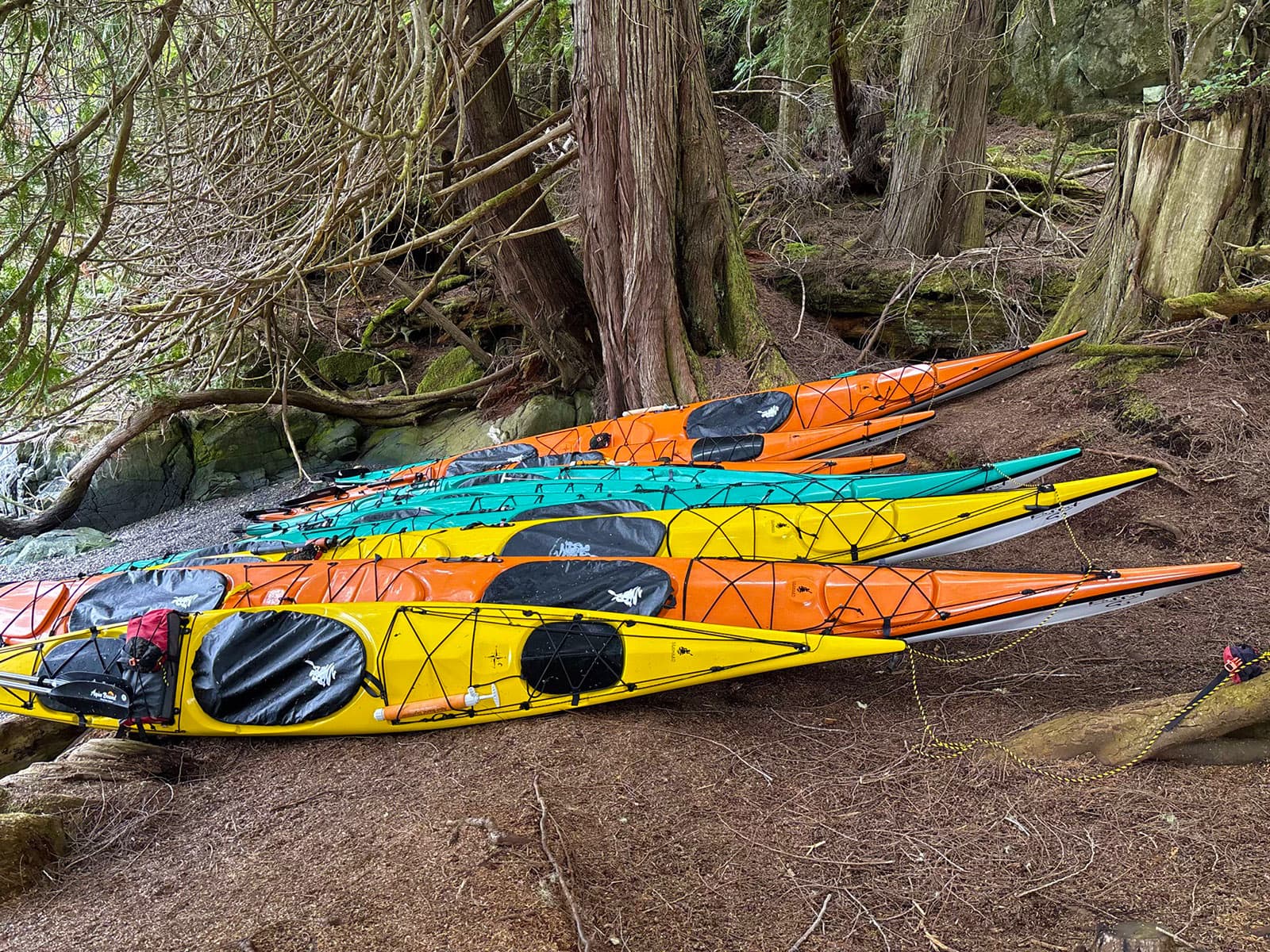
Expedition Name: Inside Passage Phase 3
Expedition Time: Thursday 8/22 – Friday 8/30, 2024 (8/22,29 & 30 were travel days).
Expedition Organizer: Karibu Adventures Tour Company Information:
They are located at:
Address: 4159 Ramsay Cres NW Edmonton, AB Canada T6H 5M9
Phone : 1- 888-969-7712
Guides: Andrew Jones (Kingfisher Wilderness Adventures), Thomas Namiss (Kwakiutl), Andrea Mandel-Campbell (Owner), Paddling guides (3) from Kingfisher, and a water guide from Sea Wolf Adventures.
Expedition Budget: $7,000 (Major components – airline tickets, tour cost, rescue insurance)
Expedition Craft:
- Seaward Passat G3 tandem Kayak, Seaward Aurora 17 solo kayak
- Water guide boat (twin engine)
- Multiple water taxis and ferries
Expedition Team: I was supported by Tom McGuire MN’22 of the Explorers Club basing in Cedar Park, TX. Tom’s role was to be my eyes in the sky, tracking weather patterns, monitoring my progress, and maintaining our connection across miles of wilderness. Our approach and communication workflow were bridging the gap between my isolated adventure and the connected world following along via social media.
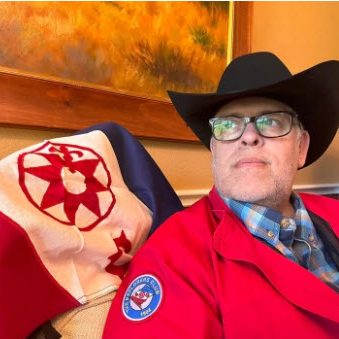
On the ground, I was supported by Thomas Namiss, a member of the Musgamakw Dzawada’enuxw First Nation (Kwakiutl), Thomas and his team of Indigenous guides combine expert grizzly bear and whale spotting along with rich local storytelling. Our Guide for the Great Bear Rainforest and Knight Inlet was also a member of that tribe, Sherry (Last name escapes me).
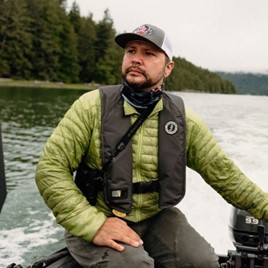
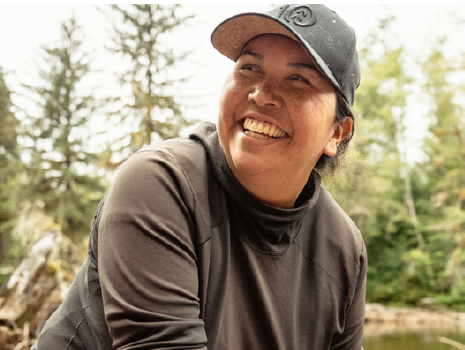
Expedition Weather: Based on the last 10 years of data, temperatures have been between 17-18° C / 71-56° F. Sea temperatures have been between 14-19° C / 44-50° F.
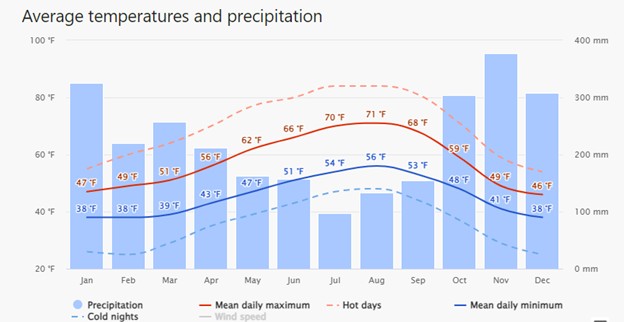
During my expedition, days were in the mid 50’s, nights around 45-52, we had rain on 2-3 days and sunshine sporadically. Most days were overcast with lots of fog. One day, Monday, 8/26 saw heavy rain, close to a foot of rain, and high winds preventing us from getting on the water.
Indigenous Interaction:
Half of the trip was dedicated to advancing my knowledge of the Kwakwaka’wakw first nation, also known as the Kwakiutl. There are 18 different tribes / bands that make up the Kwakwaka’wakw First Nation. They are Indigenous peoples from the Pacific Northwest Coast of North America. They reside primarily in British Columbia, Canada on both Vancouver Island and the islands, waterways, rainforest, and lands around the Inside Passage. A research paper has been written on this nation.
The Trip Begins
The first day of any expedition is always a psychological quagmire. I’ve planned and plotted for months, accumulated gear and lined up my support from Tom, booked flights and carved out time in my family’s schedule. Then, on the day the adventure starts, many more things popped up preventing me from that first paddle stroke. As suspected, I found myself super tired as I awoke early to catch a 6 AM flight.
As I sat in the airport waiting to board, it reaffirmed my need to be off-the-grid for a while. I needed to step away from suburbia and merge into the dark and unplumbed depths of the Inside Passage with its pristine islands, blue ocean waters and the verdant and temperate Great Bear rainforest.
When I finally glided away in my sea kayak, I knew that I had freed myself from the inertia of preparation and was finally moving. The compounded arduousness of the planning and packing ordeal all evaporated as I set off. Now I just had to paddle, camp and eat—a simplicity that instantly put me at peace.
The Kayaking Expedition:
Our rendezvous point was Port Hardy, British Columbia on the northwest corner of Vancouver Island. From there, we took a water taxi to get to our base for the next 3 days. We made our base camp on Hanson island, 50.5753° N, 126.7433° W at a place called “The Point”. It is located on the far southwestern side of the island. Base camp consisted of several canvas wall tents with beds on raised platforms using air mattresses and sleeping systems (bag, liner, and pillow). A woolen blanket and lantern were provided also. Pit toilets and Rain Barrel showers were set up.
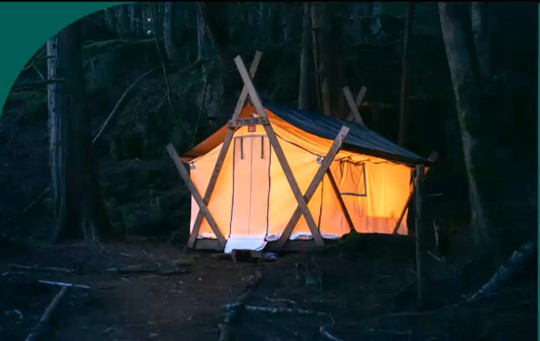
There was a communal eating area and a cooking area.
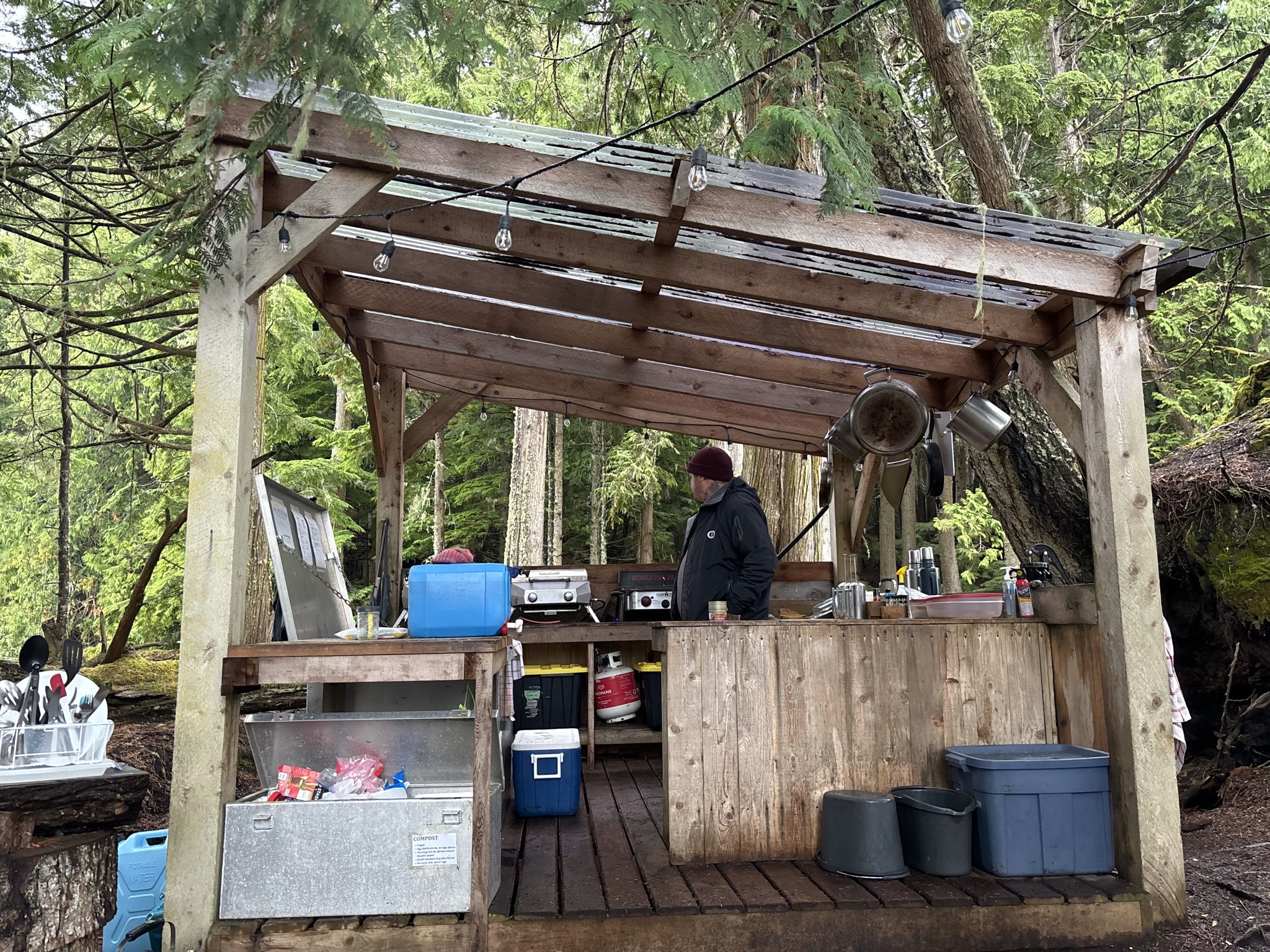
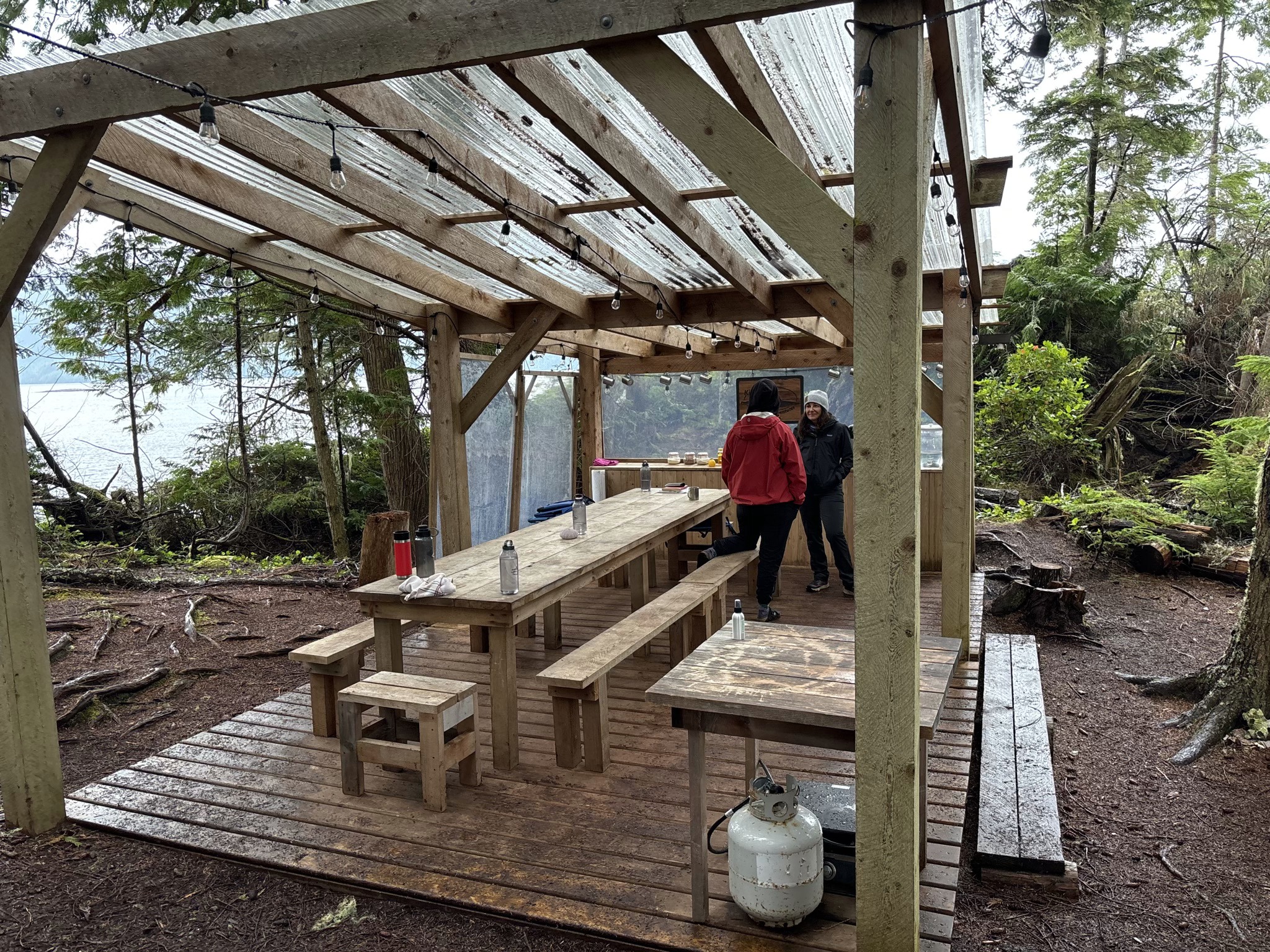
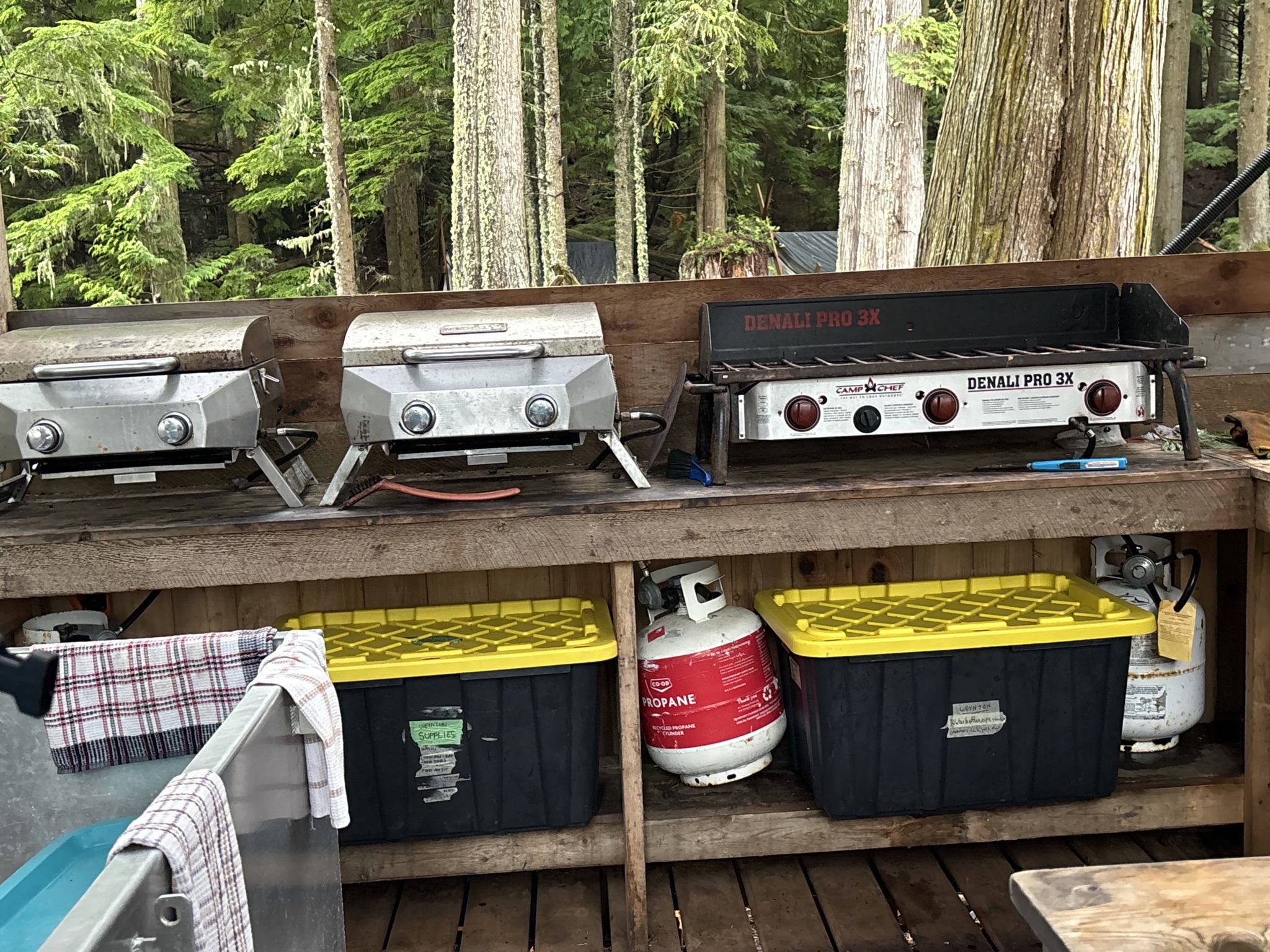
Explorations by Day: Write ups/blogs for each day can be found on my website at https://reflectionsoffthegrid.com/inside-passage-3/. Below is a daily overview (travel days not included):
8/23: From Port Hardy we traveled overland to Fort Rupert to visit with artist Calvin Hunt to learn about totem pole carving and tour his studio. Calvin is a world-renowned artist from the Northwest Coast Kwakwaka’wakw community.
8/24: We departed from Port McNeill via a water taxi to our base camp on Hanson Island. After setting up camp, we kayaked among the islands in Johnstone Strait and Broughton Sound.
8/25: Different kayaking routes within Johnstone Strait and Broughton Sound.
8/26: Weather cancelled kayaking. Base camp activities consisted of our Indigenous guide teaching us about how the tribes made use of plants and trees for clothing, medicinal purposes, canoes, tools etc.
8/27: Departing from Hanson Island via water taxi, we made our way through Knights Inlet to Glendale Cove (Great Bear Rainforest) to see grizzlies and marine and other wildlife. Learning about the controversial fish farms.
8/28: Leaving Port McNeill, we traveled via ferry to Cormorant Island (Alert Bay) to visit the Namgis tribe, listen to a discussion with K’odi Nelson of the Nawalakw Foundation, visit the tribes small fruit and vegetable farm, and tour the U’mista Cultural Center. After the day’s activity, we boarded a water taxi for a trip to Telegraph Cove to tour and have dinner.
***Paddling routes follow below at the end of the report
Key documentation and resources:
There are a couple documents I produced in addition to this trip report. They can be requested by emailing me at explore@reflectionsoffthegrid.com, They include a Trip Planning Guide and a paper on the Indigenous first nation. I also have a paper on all the prominent tribes of the Inside Passage.
To read each blog (one per day) see the link in the Explorations By Day section below.
To read about how I received needed support for the trip, please visit https://tom-mcguire.com/behind-the-screens-supporting-bob-reins-inside-passage-expedition/
To learn about the Nawalakw foundation and the work of K’odi Nelson, visit https://nawalakw.com/
To learn about renowned artist and totem pole carver Calvin Hunt, visit https://www.calvinhunt.com/
Land and Marine Life Spotted:
Whales (Humpback and Orcas), Porpoises, Sea Otters, Sea Lions
Grizzly Bears, Deer, Bald Eagles, Banana Slugs
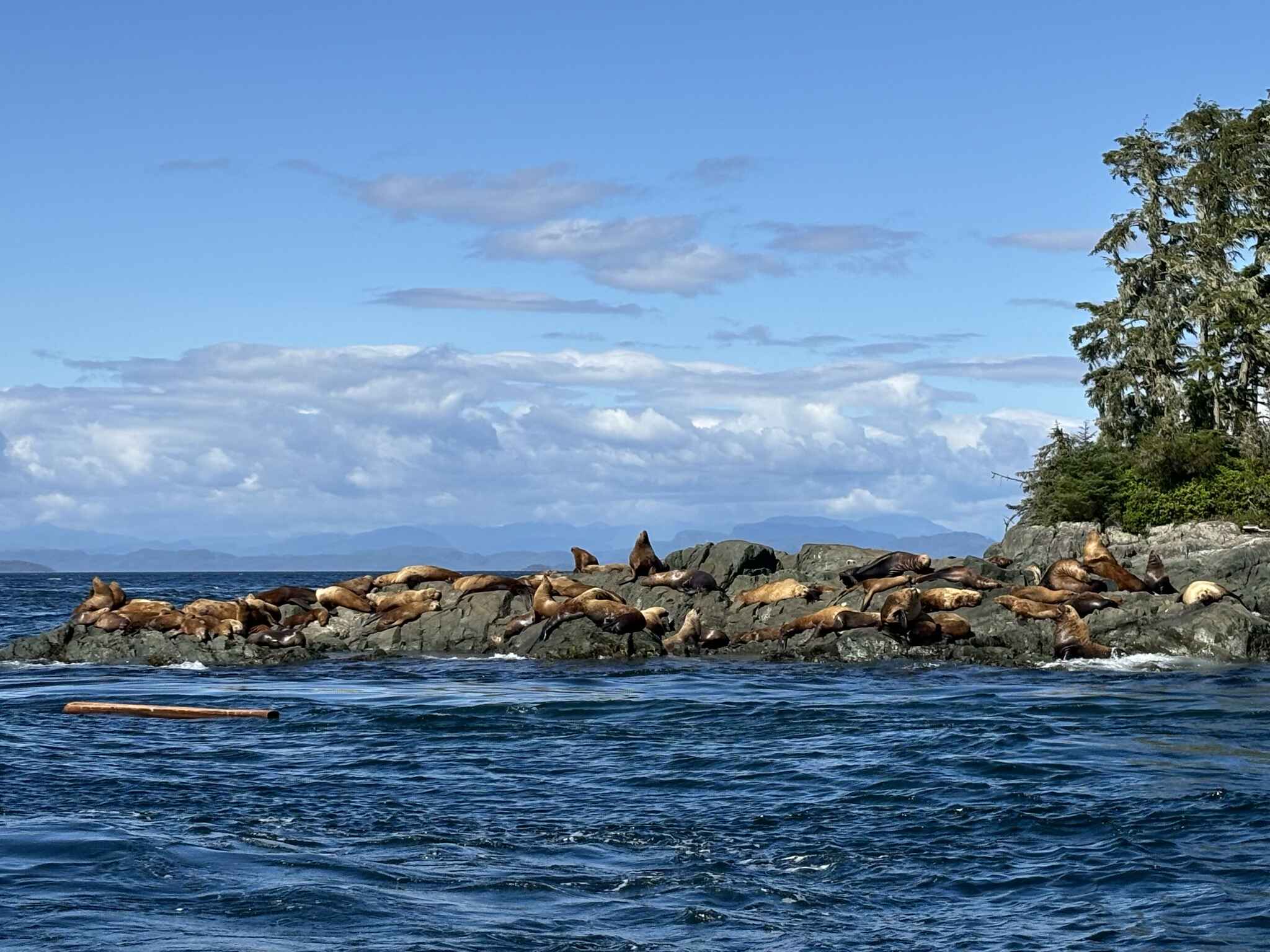
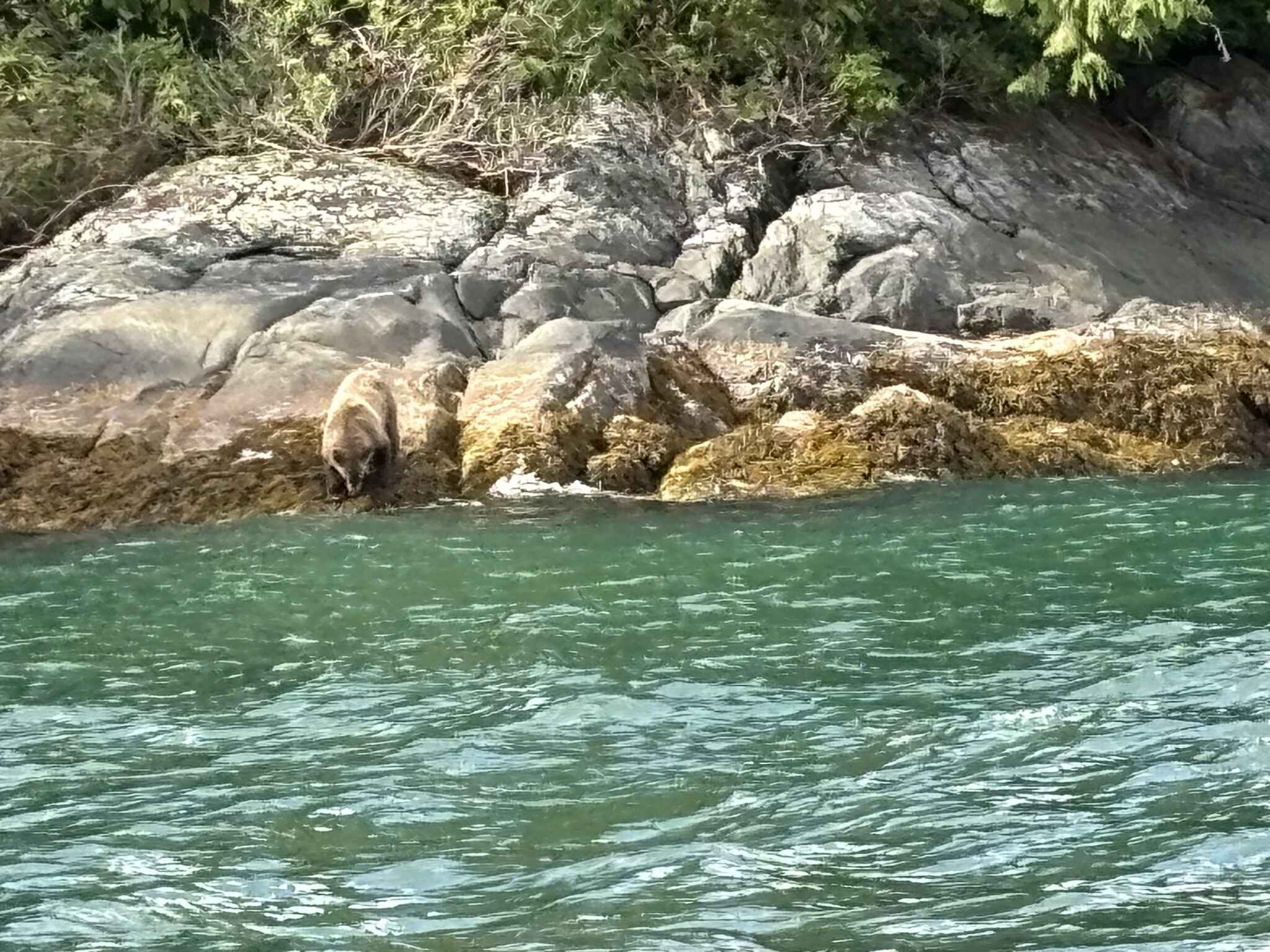
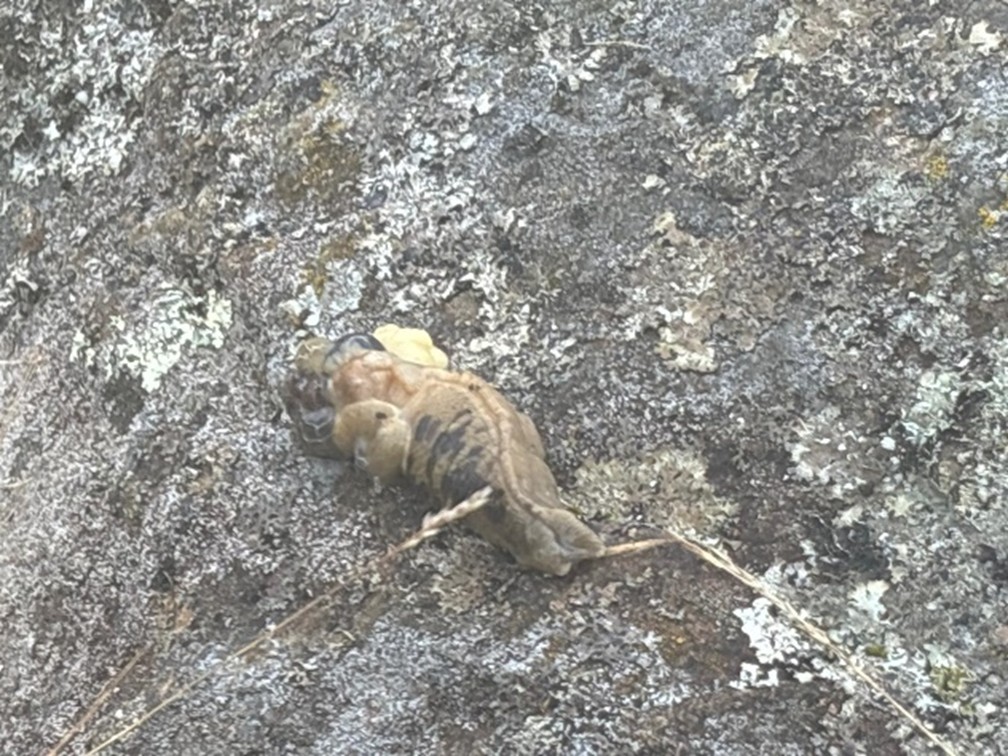 A Banana Slug
A Banana Slug
Post Trip Analysis
Overview:
My overall impression of this trip was fairly positive. I accomplished all four of the goals that I had set. The trip was a combination of both kayaking and Indigenous culture familiarization. The guides were incredibly good, and I am very pleased with their knowledge and abilities. Management of the trip was somewhat lacking, according to my expectations. It’s funny how relatively minor mistakes and inconveniences can affect your perception of the trip. This trip is not for everyone. It worked for me because I have this thirst for sea kayaking and learning about Indigenous culture. Having a support person enhanced the trip so much. It was my first expedition where I used support and it really enhances the adventure experience.
When I decided to do this trip, I had four goals in mind. The first was to explore a more northern section of the Inside Passage. I certainly got to see marine life, nature and land wildlife, and awesome scenery all from a kayak. My second goal was to immerse myself in the Indigenous culture of the Kwakiutl people. I not only did this, but I made relationships that will last way beyond the scope of this trip. The third goal I had was to visit the Great Bear rainforest. I not only visited the forest, but I also got to see the Grizzly Bears that are legendary within this massive unceded territory that the tribes own. The last goal was to simulate a longer more complex expedition via the use of support. My support came in the form of Tom McGuire. Tom assisted me in transmitting daily weather, water, and environmental conditions so I would have a preview of what to expect. I would then relay back what I was seeing on the ground so he could determine the accuracy of the models that he was built and was using. Another part of the experiment was to see how someone in the field can communicate on social media daily through blogs / postings and Social Media, exactly what I was experiencing in the field. Each night I would send rudimentary notes and pictures and videos. Tom would then turn them into blogs and then post them to my website. From reading Tom’s daily posts, you know that was a success also.
What went right:
- I got a good feeling of my current capabilities to camp out in true wilderness and not sterile campgrounds.
- I got further experience by paddling in very large bodies of open water (Johnstone Strait and Broughton Sound). I had previously paddled in the Straits of Georgia.
- I spent lots of time having one on one discussions with Kwakiutl people (Thomas Namiss, Calvin Hunt, K’odi Nelson, Sherry from Sea Wolf, 3 men and women from the small farm). This was the deepest dive that I have done with my indigenous research.
- I got to experience kayaking and camping, in less-than-ideal weather conditions.
What went wrong:
- I brought stuff I didn’t need and I did not bring stuff I could’ve used. There was a lack of accurate communication and information. Even though I had a checklist, I forgot some items that I really could have used. I need to revise my checklist.
- We did not get to visit Hada within the Great Bear Rainforest but rather settled to meet K’odi Nelson of a small farm in Alert Bay.
- Blowing out my knee was a major factor in making what should have been a great experience in Alert Bay and afterwards, a painful experience.
- Being colorblind, I missed opportunities to see some marine life to the fullest as the animals were away from our boats and blended into the sea and the sky.
- I was not impressed by the administration of the trip. Maybe it is unfair to compare them to the tour company in Desolation Sound as these were two completely different types of excursions.
- The flight home was a mess with cancellations causing missed flights, and typical traveling delays. Thankfully I got to see my son and daughter-in-law as I wound up sleeping at their house in Vancouver due to the forced layover.
- I overshot budget by $450 due to gear purchases not anticipated and rescue and evacuation insurance beyond the free Explorer’s Club provision.
Kayaking Paddling Routes
8/24/2024
Note: Paddling times were impacted by frequent stopping for marine life observations. Thus a trip that would normally take an hour, might take as long as an hour and a half – 2 hours to observe sightings of whales, sea lions, porpoises, sea otters, etc.
Launch to lunch stop
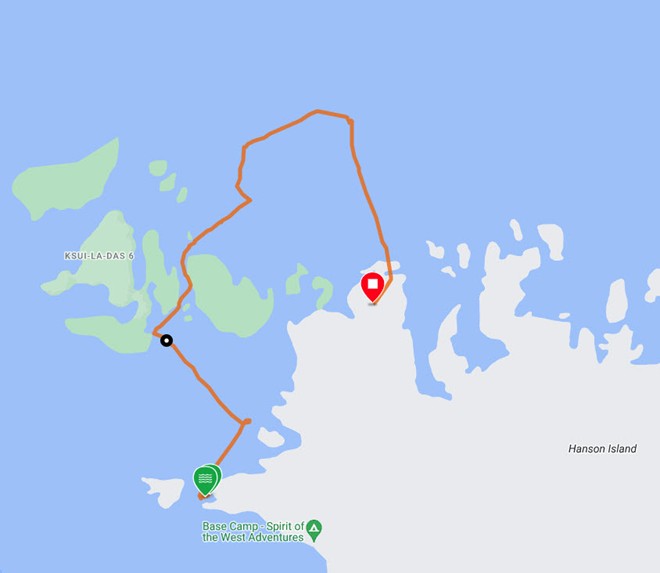 3.84 miles / 2 hours 26 minutes
3.84 miles / 2 hours 26 minutes
Lunch stop to base camp
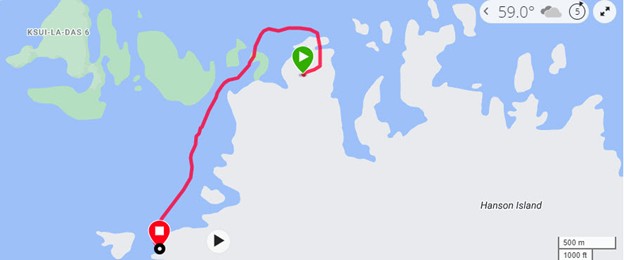 1.98 miles / 1 hour
1.98 miles / 1 hour
8/25/2924
Launch to lunch stop
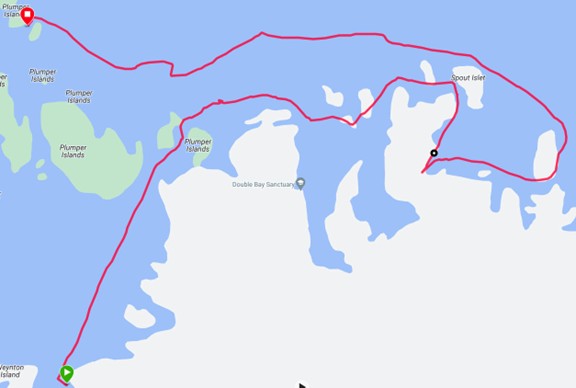 6.24 miles / 3 hours 29 minutes
6.24 miles / 3 hours 29 minutes
Lunch Stop to Base Camp
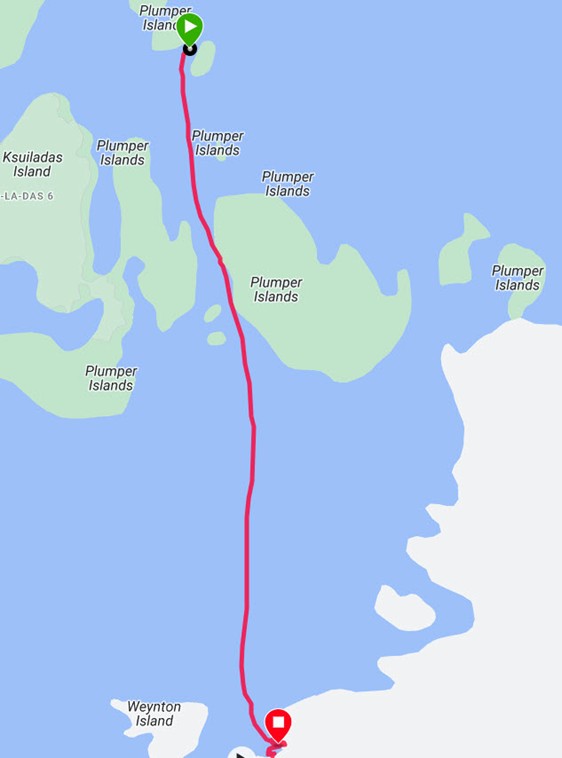 1.71 miles / 1 hour 33 minutes
1.71 miles / 1 hour 33 minutes


